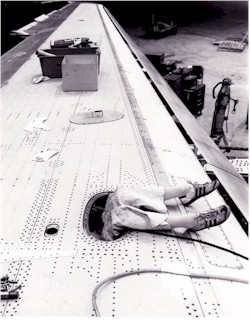|
Paul Dhillon sends this information regarding the tank sealers article published in NetLetter # 1475 -
I do not have a credit for the photo. |
|
David Varnes, Chair of the IAM LL 764 history committee, added this comment - The more interesting item was the specifications for the mechanic who did this; there were height and weight restrictions, and often, a "smaller person" in the Maintenance Branch found themselves continuously assigned to tank inspection, notwithstanding their seniority standing. |
|
Paul responded - Yes, in YVR there were a few guys from the Philippines in maintenance that were the preferred dimensions (HxW, where W referred to Weight and Waist). I think the work also attracted a premium on their hourly rate. |
|
Doug Davidson shares this memory - Mike Nash’s story, published in NetLetter # 1475, of the first automated ticket brought back memories (although I can’t remember the fun parties - I must have missed out on those). It was a revolution at the front end but also downstream for Winnipeg C & SS and Finance. With hand-written tickets, the audit coupon had to be keyed in great detail. When the flight coupons came in from the airports, all that was needed was the ticket number and coupon number and those could be captured by an optical scanner. When RES printed the tickets, all the sale data was saved and transmitted to Winnipeg. That eliminated the manual keying and the inevitable errors that went along with that. There was just one problem - a major one. RES didn’t know the ticket number it had just printed. Mike is quite correct. Tickets were accountable documents. Flight coupons had value, just like bank notes, and were therefore tightly controlled. When they were manufactured each ticket had a unique number which was only used once worldwide. So the sale records sent to Winnipeg were useless until we had attached the correct ticket number. The solution was to have RES generate a unique TCN (Transaction Control Number) which was printed on the ticket and included with the rest of the ticket record sent to Winnipeg. When the audit coupons came in, they still had to be keyed but only with the TCN and the ticket number. The required keypunching was a small fraction of what had been required previously. My good friend Barry Schreder told me - speaking from memory - that Canadian took a different route. When a new roll of tickets was loaded in the printer, the agent would tell Res what the first ticket number was. So the ticket detail sent to revenue accounting by RES was complete and as each ticket was issued, RES just added 1 to the previous number and no keypunching was required. It wasn’t foolproof, of course. When a ticket was issued, agents were required to check that the ticket number in their hand was the same as the one on the screen. If, for example, a roll had broken, been rejoined and two tickets destroyed, the rest of the run would have ticket numbers that were all wrong. They would be out by two. If it wasn’t caught and corrected up front, this was a monumental snafu that had to be sorted out manually in revenue accounting. |
|
Colin Waters sends us this memory - I refer to Mike Ronan's experience, published in NetLetter #1475, on the DC-9 from YVR to YYZ I joined Air Canada in 1966 as a Second Officer on the DC-8. Sometime around 1968, I was promoted to First Officer after being checked out by George Campbell. As I recall, George had initiated a YVR to YYZ trip on a 'short' DC-9. Do not remember flight details but do recall some ATC personnel remarking on the accomplishment of a nonstop flight and passenger surprise. George was suitably impressed. There was much checking of the fuel situation and weather conditions en route. Sincerely, Colin M Waters, retired in 2000 off the A340. |
|
Editor's Note by Ken Pickford: 'Short' refers to the shorter fuselage of the 6 original AC DC-9-14's operated for about 2 years from 1966 to 1968 as a stopgap while waiting for the -32 series which had a 15 foot longer fuselage and about 5 more rows of seats. The "short" DC-9s were returned to McDonnell Douglas in mid to late 1968 after the first 20 or so DC-9-32's had been delivered. Bob Sheppard's memories below refer to a later batch of 8 'short' DC-9's acquired from Continental Airlines in 1972/73 (all delivered to Continental in 1967). They were passenger/cargo convertible models with a main deck cargo door, known as DC-9-15RC ("rapid change"). At AC they were Fin #s 761 to 768, registered CF-TON through TOU. They were used in both passenger and cargo service at AC. They were all sold to Air Florida between 1977 and 1981. Two of those aircraft are still flying today as freighters, one in the U.S. and one in Mexico, almost 55 years since they were built. Bob Sheppard's memories of the DC-9-15RC's: I remember cleaning short DC-9 aircraft in 1977 or 1978 at YYZ. I appreciated it being about 5 rows shorter at the time. I was originally hired as summer help wet washing aircraft. I later stayed on as a CAT 33 cleaner/groomer until I transferred to Cat 13 finishing / T&F. Finally transferring to Winnipeg in 1980 to work on B-727 C&D checks. |
|
Additional DC-9 references in past NetLetter issues. NL #1342 - DC-9 Fleet NL # 1450 - DC-9-15RC (Rapid Change) Click Here for our full list of Air Canada's DC-9 fleet. |

